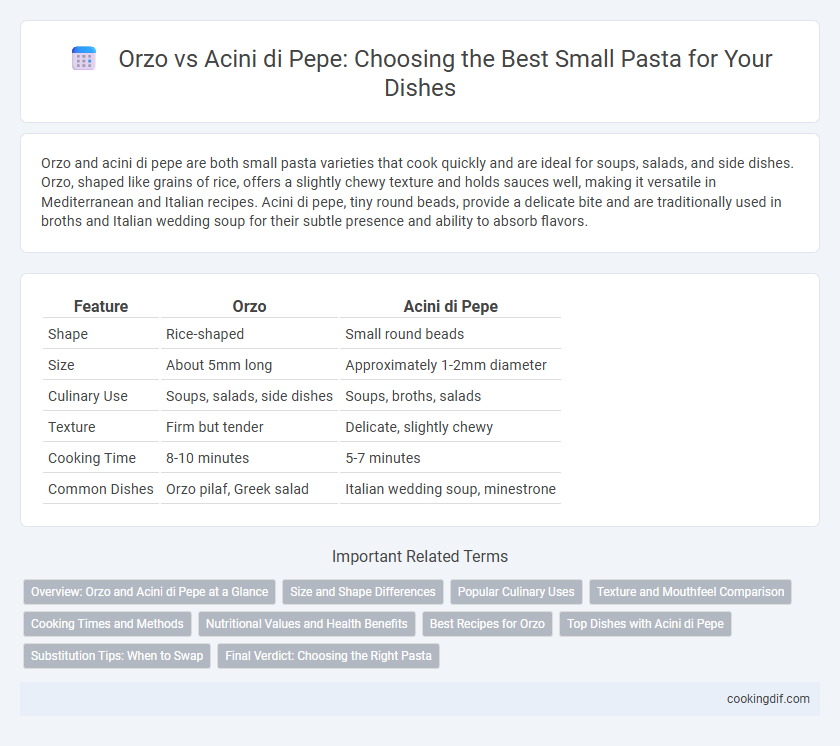Orzo and acini di pepe are both small pasta varieties that cook quickly and are ideal for soups, salads, and side dishes. Orzo, shaped like grains of rice, offers a slightly chewy texture and holds sauces well, making it versatile in Mediterranean and Italian recipes. Acini di pepe, tiny round beads, provide a delicate bite and are traditionally used in broths and Italian wedding soup for their subtle presence and ability to absorb flavors.
Table of Comparison
| Feature | Orzo | Acini di Pepe |
|---|---|---|
| Shape | Rice-shaped | Small round beads |
| Size | About 5mm long | Approximately 1-2mm diameter |
| Culinary Use | Soups, salads, side dishes | Soups, broths, salads |
| Texture | Firm but tender | Delicate, slightly chewy |
| Cooking Time | 8-10 minutes | 5-7 minutes |
| Common Dishes | Orzo pilaf, Greek salad | Italian wedding soup, minestrone |
Overview: Orzo and Acini di Pepe at a Glance
Orzo and Acini di Pepe are both small pasta shapes commonly used in soups and salads, with Orzo resembling grains of rice and Acini di Pepe appearing as tiny, round beads. Orzo has a slightly larger size and a smoother texture, making it ideal for dishes requiring a more substantial bite. Acini di Pepe's diminutive size and delicate shape excel in light broths and casseroles where subtle texture is preferred.
Size and Shape Differences
Orzo is rice-shaped pasta, typically measuring about 7-8 millimeters in length, ideal for soups and salads due to its slender, elongated form. Acini di pepe, meaning "peppercorns" in Italian, consists of tiny, round pasta pieces approximately 1-2 millimeters in diameter, perfect for broths and light sauces. The size and shape differences influence cooking time and texture, with orzo providing a heartier bite while acini di pepe delivers a delicate, pearl-like consistency.
Popular Culinary Uses
Orzo is widely used in Mediterranean dishes such as soups, salads, and pilafs due to its rice-like shape and ability to absorb flavors. Acini di pepe, characterized by its tiny, round beads, is commonly found in Italian wedding soup and cold pasta salads, providing a delicate texture that holds up well in broths. Both pastas cater to distinct culinary applications, with orzo favored for heartier recipes and acini di pepe preferred in lighter, broth-based or chilled dishes.
Texture and Mouthfeel Comparison
Orzo offers a smooth, slightly chewy texture that resembles rice, providing a creamy mouthfeel when cooked al dente. Acini di pepe, with its tiny, bead-like shape, delivers a firmer bite and a more distinct, popping sensation in the mouth. The subtle differences in texture make orzo ideal for soups and salads requiring a soft base, while acini di pepe excels in dishes where a firmer, granular mouthfeel enhances the overall eating experience.
Cooking Times and Methods
Orzo typically cooks faster than acini di pepe, requiring about 8 to 10 minutes to reach an al dente texture, while acini di pepe usually needs 10 to 12 minutes due to its smaller, round shape. Both pastas are best boiled in salted water, but orzo's rice-like shape absorbs liquids differently, making it ideal for risottos and soups where a creamier consistency is desired. Acini di pepe, with its tiny pearl shape, is perfect for clear broths and chilled salads as it maintains a firm bite and doesn't overcook easily.
Nutritional Values and Health Benefits
Orzo and acini di pepe are small pasta shapes with similar carbohydrate content, but orzo tends to have slightly more protein and fiber per serving, supporting muscle repair and digestive health. Both provide essential B vitamins and iron, though orzo made from whole wheat offers higher antioxidant levels and a lower glycemic index, promoting better blood sugar control. Acini di pepe's tiny size is ideal for portion control, potentially aiding calorie management while still delivering energy and essential nutrients for overall wellness.
Best Recipes for Orzo
Orzo, a rice-shaped pasta, excels in versatile recipes like Greek lemon chicken soup and creamy orzo salad, providing a tender texture that absorbs flavors well. Compared to acini di pepe, which is smaller and often used in soups and Italian desserts like pastina, orzo offers more substance, making it ideal for pilafs and casseroles. Its plump shape holds sauces beautifully, enhancing dishes with rich, savory ingredients.
Top Dishes with Acini di Pepe
Acini di pepe, a tiny, round pasta resembling peppercorns, excels in dishes like Italian wedding soup and Mediterranean salads, where its small size adds texture without overpowering other ingredients. Unlike orzo, which is rice-shaped and commonly used in soups and pilafs, acini di pepe holds up well in brothy soups and chilled pasta salads due to its firm bite and ability to absorb flavors. Its versatility in both hot and cold preparations makes acini di pepe a top choice for recipes requiring delicate pasta elements.
Substitution Tips: When to Swap
Orzo and acini di pepe are both small pasta shapes ideal for soups, salads, and side dishes, but they differ in texture and cooking time. Orzo, resembling large grains of rice, offers a slightly chewier bite and works well when a heartier texture is desired, while acini di pepe, tiny round beads, cook faster and create a delicate, almost creamy consistency in brothy dishes. When substituting, use orzo for recipes requiring a more substantial pasta presence and acini di pepe for lighter, smoother textures or when precise cooking times are crucial.
Final Verdict: Choosing the Right Pasta
Orzo provides a slightly larger, rice-shaped pasta ideal for hearty soups and pilafs, offering a chewy texture that holds sauces well. Acini di pepe consists of tiny, bead-like pasta perfect for light broths and delicate salads, creating a subtle presence without overpowering other ingredients. Selecting between orzo and acini di pepe depends on the desired dish texture and flavor balance, with orzo favoring substance and acini di pepe excelling in finesse.
Orzo vs acini di pepe for small pasta Infographic

 cookingdif.com
cookingdif.com